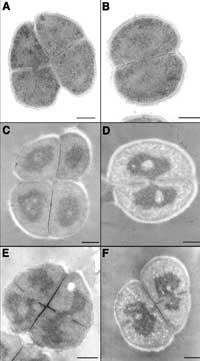Key to radiation resistance
2003/01/13 Galarraga Aiestaran, Ana - Elhuyar Zientzia
Scientists investigate the key to bacterial resistance and publish in the journal Science the conclusions of the research. According to them, the resistance of Deinococcus radiodurans is due in part to its morphology or appearance.

The research has been carried out at the Wiezmann Institute of Israel. In scanners made using an electronic microscope, the bacterium has seen that it has four copies of the genome, each in a compartment. In addition, the genome is donut-shaped, which allows the affected parts to be kept in place during the fragmentation of the bacteria.
To study genome repair, thousands of bacteria have been subjected to high doses. Subsequently, during the repair tasks, the freeze is proceeded, observing the phases of the repair mechanism. In this way they have discovered that in the first phase the genomes of the four compartments do not lose their aspect of donuts. In the second phase, the genome expands and each copy sends its parts to the other compartments. These parts are mixed with other copies and the affected areas are repaired. In fact, it is almost impossible for the four copies to damage the same places, and the parts of the copies that have not been damaged can repair the damaged ones in the other compartment.
However, some scientists do not agree with the conclusions obtained from this research. They say it is necessary to see if the rest of the bacteria that have resistance to radiation have the same aspect: if they did not have it, the reason of resistance could not be attributed to it.

Gai honi buruzko eduki gehiago
Elhuyarrek garatutako teknologia




